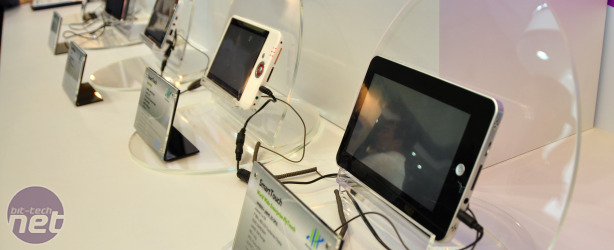What happened to VIA? Tablets, platforms and x86 v ARM
August 10, 2010 | 08:40

Big Markets and ARM vs x86
BT: You've turned away from the areas bit-tech readers might traditionally associate you with, so what are your big markets now?VIA: We’re very strong in the thin client space; no-one puts out official numbers but we estimate we’re number one in the thin-client market. We think that market will only continue to grow as we see a growth in cloud computing so we’re putting a lot of emphasis on it.
Then there's embedded. We started x86 form factor innovation in embedded firstly with mini-ITX, then Pico-ITX, then Nano-ITX. We started with a model based on designing just the form factors, but now we provide complete products. Another area we are starting to see seeing growth is low power servers: last year Dell adopted us for one of their Fortuna, which is a hyperscale server for data centre application, and for certain applications like just serving web-pages, our CPUs are absolutely ideal.
The data centre guys’ measure very carefully and know exactly how much processing power they need. Even when a Nano processor is running at 100 per cent utilisation it's consuming less power than an Intel [server] CPU that's in suspend mode, and we’re certainly highlighting those benefits, so we’re seeing is more growth in that area – especially in new Chinese markets and especially with the increase in cloud computing and web services.

At Computex, VIA's stand featured tens of VIA and Android powered tablets made by unheard of Chinese brands
BT: I was told by yourselves that ARM is better for tablet products. Is it even possible to make an x86 CPU that scales to fit into that sort of device?
VIA: We do have customers with tablets based on the C7M and Nano. I think the difference is that with x86 the price point is much higher, and it’s not limited to just the CPU cost – it’s the whole infrastructure. The software is generally more expensive, the memory requirements are higher, the component costs are higher, the motherboard is more complex, and to get tens of hours of battery life you need a very good battery, so the overall material cost is much more expensive. It’s mainly for professional and vertical markets where x86 tablets are popular.
I think the ARM tablet business - in terms of volume - will be ahead for quite a while, and the simple reason is cost. We have customers who are selling VIA, or WonderMedia which is our subsidiary company selling tablets for a retail price of 999RMB in China ($130 US), and is a very successful product for them. Currently with x86 it’s absolutely impossible to reach that price point.
Secondly, if we look at software, Android is the platform of choice and it obviously runs on ARM very well. Now, three to five years down the line when power consumption continues to decrease to increase [power per watt] performance, then x86 will possibly become more popular, but until then ARM will be predominant.

MSI MPG Velox 100R Chassis Review
October 14 2021 | 15:04








Want to comment? Please log in.